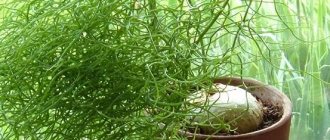Author: Natalya Category: Garden plants Published: January 08, 2019Republished: February 09, 2019Last edits: January 20, 2021
- Forcing home calla lilies
- Ethiopian calla (Calla aethiopica)
Many calla lily lovers do not even suspect that its characteristic elegant snow-white or brightly colored “bags” are not flowers at all, but... special leaf-spreads that wrap the yellow ears of the inflorescences. Calla blooms inconspicuously, but very fragrant! We will reveal more secrets of the exotic beauty in our article.
- What to do if calla lilies do not sprout for a long time after planting?
- Why does calla lily begin to “cry”?
- Is it worth planting callas near large bushes and trees?
- Why can calla lilies lose color?
- How to get calla lilies to bloom earlier in the garden?
Let's figure it out together.
Planting and caring for callas
- Planting: tubers are planted in early May.
- Flowering: from June to early October.
- Excavation: in September.
- Storage: in an earthen coma in a dry room at a temperature of 5-7 ˚C.
- Lighting: bright light in the morning, light partial shade in the afternoon.
- Soil: well-drained, fertile, pH slightly acidic to acidic.
- Watering: moderate but regular, abundant in dry seasons.
- Fertilizers: Fertilizers are applied to the soil only during planting.
- Reproduction: vegetative, depending on the type - by tubers or dividing the bush. Seed propagation is ineffective and unreliable.
- Pests: aphids, thrips, mole crickets, beetles and wireworms.
- Diseases: rhizoctonia, root rot, penicillosis, pythium, Erwinia group of bacteria.
- Properties: the plant contains poisonous alkaloids. The juice, if it comes into contact with the skin, causes irritation, and if it enters the body, it causes vomiting, numbness and convulsions.
Read more about growing calla lilies below.
Calla plant (lat. Calla) , or Zantedeschia (lat. Zantedeschia) is a genus of perennial plants of the Araceae, or Aronicaceae family. The calla flower grows in damp places in South America and Africa, from Nigeria to Tanzania. It is a relative of such a plant as calla lily, or marsh calla, the only representative of its genus, whose range is located in the Northern Hemisphere. Zantedeschia is sometimes called Ethiopian calla lily, or Richardia. The flower received the name “zantedeschia” from the German botanist Kurt Sprengel, who named it in honor of his friend the Italian botanist Giovanni Zantedeschi, but most often zantedeschia is still simply called calla lily. The attractiveness of this plant for gardeners is not only in the very large, showy leaves and unusual flower shape, but also in the fact that calla lilies can be grown both in the garden and at home, in a pot.
Features of the plant
Growing callas, like any other plant, requires following the rules of agricultural technology, but the main feature of these flowers is that they are grown both as garden callas - in courtyards, and in apartments, in pots, like indoor callas. But there are still general rules for growing and caring for callas, no matter where they grow:
- Croton (Codiaeum) – care, photos, types
- callas require shallow planting, that is, the rhizomes are barely covered with soil to avoid rotting;
- What laymen call a calla flower is actually the covering leaf or spathe that wraps the spadix of the inflorescence. In fact, calla flowers are small and inconspicuous, although very fragrant;
- after planting, calla lilies do not sprout until they have formed their root system, so do not be nervous if there are no sprouts for a month;
- When digging up tubers, be careful: they are easily damaged;
- calla is a living barometer: droplets of water appear on its cover and the tips of its leaves before the rain, like tears;
- A pot for calla lilies, especially Ethiopian, is preferably porous so that excess moisture can evaporate. In addition, Ethiopian calla loves privacy and does not tolerate neighbors in its own pot;
- each calla flower blooms for about a month;
- From time to time, the top layer in the calla pot should be carefully removed, trying not to damage the roots, and replaced with fresh nutrient substrate.
Transition of the plant into the resting phase
After a plant with any type of color fades, its watering should be reduced. After two to a month and a half, stop watering altogether, since at this time it enters the resting phase. There is no need to do this abruptly, as the transition should be smooth. During this time, the tubers of the plant will ripen, after which the leaves can be cut off. White or colored calla flowers will remain in the resting phase for 4-5 months, approximately from October to February. This period and date are approximate, as they depend on many conditions and are individual for each plant.
Growing garden calla lilies
Callas decorate the garden so much with their majestic flowers that many gardeners are happy to grow them on their farms. The clearings where calla lilies grow look like an Arabic ornamental painting: the rhizomes annually produce young leaves, and elegant arrow-peduncles rise among them...
In the photo: Purple callas
Callas prefer open, spacious areas and fertile soils, but it is advisable to shade them during the hottest hours of the day: in the scorching sun, the leaves wither, burn and dry out, so it is important that bushes or trees grow nearby, which will provide the callas with saving shade in the afternoon. The soil must be acidic or at least slightly acidic; good drainage is required, because stagnation of water in the roots is detrimental to the plant.
The optimal composition of soil for calla lilies is: earth, sand, peat and leaf humus in equal proportions.
Planting callas and caring for the garden
Spring planting
Garden callas are planted in early May. Pre-planting material is kept for half an hour in a solution of potassium permanganate, then carefully examined and, if necessary, rotten areas are cut out to healthy tissue, and the wounds are lubricated with brilliant green. Complex mineral fertilizer is added to the soil at the site at the rate of 30-40 g per 1 m², and the site is dug up. Then the tubers are immersed in prepared holes to a depth of 5-10 cm at a distance of 30-40 cm from each other (depending on the size of the bulb), buried, and the planting site is well watered.
How to grow cannas in the garden - with showy flowers and leaves
Calla lilies, if you remember, have a peculiarity: they do not sprout until they form an underground part, so if you are lucky, you will see sprouts in about two weeks, and if you are not very lucky, then in a month. Don't despair and don't try to dig a hole and see what stage the process is at. Do not water the calla lilies for the first two weeks: watering after planting is sufficient.
In the photo: Preparing calla bulbs for planting
There is a way to prepare calla lilies for planting in open ground: at the end of March or beginning of April, plant calla lilies in small pots to a depth of 2-3 cm in special soil for seedlings or in soil calcined for forty minutes in the oven. Water 1-2 times a week, and a week before transplanting into the ground, begin to briefly open the window to harden the plant. Calla lilies are transplanted into open ground together with a lump of earth.
Planting in autumn
Calla lilies are not planted in the fall.
Caring for calla lilies
How to care for calla lilies? It turns out to be very simple. Watering the calla lily followed by loosening is all that is needed for its normal growth. Plants should be watered moderately but regularly, increasing the amount of water during watering in hot, dry summers.
After each watering, lightly loosen the soil around the plants.
If you added complex fertilizers to the soil during planting, then you will not need further fertilizing of the callas, sometimes only, if the soil in the area with callas is not acidic enough, water it with water acidified with citric acid or vinegar.
Possible problems and difficulties
Any plant is susceptible to misfortunes in the form of small pests or diseases, and calla lilies are no exception.
It is important to recognize the problem at an early stage and immediately take the necessary measures.
Calla lily diseases and care during this period
The appearance of insects can be recognized by the following signs:
- The leaves begin to curl and become covered with light spots, the flower stalks are painted with light patterns. The disease is called yellow spot, and the causative agent is insects - thrips. To combat them, the plant is treated with a diluted insecticide for flowers (Fitoverm, Aktara, Fufanon).
- Spider mites manifest themselves as dry leaves and the formation of small cobwebs on them. It develops in dry indoor air, which requires adjustment after treatment with drugs.
- Deformation, curling and further falling of leaves can be signs of aphids on calla lilies. Insects feed on the sap from the leaves and leave sticky spots. In the fight against pests, it is effective to wash them off with a soap solution in the early stages or treat them with drugs:
- Aktara;
- Tobacco dust;
- Spark.
Treatment is carried out several times with a break of 1 week.
Also, if the rules of care are not followed, the plant begins to wither or stops growing.
Elongated leaves and stems with a pale color are observed with insufficient lighting time or lack of intensity.
With a lack of nutrition, the leaves begin to break off, which is usually combined with a lack of growth and flowering.
Anthracnose
Anthracosis may be one of the reasons why the leaves of indoor calla lilies turn yellow. Brown spots resembling rust appear on the leaf blades. Later the leaves dry out completely and fall off.
Anthracosis requires removal of damaged areas and treatment with a fungicidal agent.
Gray rot
The appearance of a gray coating on the leaves indicates the presence of a fungal disease. Treatment with a fungicidal preparation (Vitaros, Fundazol) can save the plant.
To prevent subsequent infection, frequent ventilation of the room and reduction of watering and spraying are required.
Bacterial rot
Bacterial rot develops on roots in too wet a substrate. The disease manifests itself as leaf rotting and death. Tubers or rhizomes become covered with dark spots. The plant is very difficult to save, even at an early stage. It is necessary to completely cut off all affected areas, treat them and plant them in new soil, reducing the frequency of watering.
Root rot
Unexpected drying of leaves or flowers may be a consequence of overwatering and the development of root rot. To combat it, the soil should be treated with Ridomil or Previkur, and the upper part should be replaced with a new one. Prevention is moderate watering and periodic change of the top layer of the substrate.
No flowering
If the calla lily does not please its owner with elegant flowering , then the most likely reasons lie in improper care of the plant:
- Lack of space in the pot, which is not always reflected in the growth rate of foliage, but may be the reason why calla lilies do not bloom at home.
- Insufficient lighting and frequent moving of the pot from place to place. The flower is forced to constantly be under stress and adapt to new conditions, which leaves no energy for the formation of buds.
- Lack or lack of fertilizing, especially before the start of the active period. The cause may also be the alkaline reaction of the soil, which does not allow food to be absorbed by the root system.
- A short duration of the resting phase in a cool place, during which flower buds do not have time to develop.
- Overgrown tubers requiring replanting .
- A large amount of soil in the pot, promoting the development of putrefactive processes.
Calla at home
Forcing home calla lilies
Homemade calla lilies are grown at a temperature of 22-25 ºC in the summer, and in winter – at a temperature not lower than 14 ºC. The place for the plant should be well lit, but shaded from direct afternoon sunlight and protected from drafts. The soil for home calla lilies should have an acidity of approximately ph 6-6; it would be a good idea to add sphagnum moss or peat with sawdust to the nutrient soil. The tuber for forcing calla lilies should be about 6 cm in diameter, it is planted with the convex side down in a container with a diameter of at least 25 cm, the planting depth is 5 cm. After planting the tuber, the soil must be spilled with a fungicide solution.
How to care
Caring for home calla lilies is no more difficult than caring for garden ones. The planted tuber must be watered carefully so that it does not rot without germinating. If you want to get early flowering of callas and the brightest possible color of the bedspread, then you can resort to this trick: at night the temperature for callas is lowered to 16 ºC, and during the day they provide the brightest possible lighting, but without direct sunlight, and if forcing occurs in winter time, the calla lily will have to be illuminated with fluorescent lamps so that the daylight hours for it last for at least 10 hours.
- Polyscias at home: care and types
How to care for hippeastrum so that it blooms profusely
Fertilize calla lilies with a balanced liquid fertilizer, such as Kemira-Lux. Apply fertilizer to the soil along with water every fifth watering of the plant.
In the photo: Pink calla
Reproduction
Calla lilies are propagated by seeds (this method is unreliable, and you will have to wait a very long time for results), tubers and dividing the bush. Reproduction of calla lilies by dividing the bush is done as follows: in the fall, when digging, the calla lily shoot with part of the rhizome is separated and transplanted into a pot with an earthen mixture, and in the spring it is transplanted into open ground. If only the Ethiopian calla and its varieties are propagated by dividing the bush, then the remaining callas are propagated by tubers: in the fall the tubers are dug up, stored for the whole winter, and in the spring they are planted in open ground.
In the photo: growing calla lilies at home
Varieties
Ethiopian
A frequent guest at weddings, anniversaries and other celebrations. A distinctive feature is the white color of the bedspread, the elongated ear of yellowish color.
Details about Ethiopian calla lilies and their cultivation are described in the video:
Bolotnaya
It has a powerful root system that grows over the surface of the soil and suppresses neighboring plants. This flower is completely poisonous. The bedspread is two-color - green on the outside, white on the inside .
Elliot
A profusely flowering plant. The flowers have a rich yellow color. It is grown only by tubers.
Remani
The smallest flower. The height of an adult plant reaches 40 cm . The color of the bedspread ranges from bright pink to red.
Description of Calla Remani - in this video:
https://youtu.be/UjdNUTiMXNE
Callas after flowering
There are differences in caring for tuberous callas and rhizomatous callas. For Ethiopian calla, rhizomatous, the dormant period begins in the very heat - at this time growth slows down, then stops, the calla turns yellow... At this time, watering should be reduced, and the plant should be taken to the balcony or garden in a well-lit place where drops will not reach it rain. In the first half of July, the plant is taken out of the pot, all old leaves and shoots are removed and transplanted into a pot with a new nutrient mixture, placed in a bright place and they begin to water and feed the calla, preparing it for the next flowering. This is the cycle of rhizomatous potted calla lilies.
Garden calla lilies remain on the site until autumn; in September, the rhizomes are dug up and stored with a ball of earth in a cool, dry room with moderate, infrequent watering.
In the photo: Calla in a pot
After flowering, tuberous calla lilies gradually turn green and droop, the leaves turn yellow and dry. Garden tuberous callas are carefully dug up in the third decade of September, trying not to damage the tubers, freed from the soil, washed and kept for a couple of weeks at a temperature of 5-10 ºC, waiting for the beneficial nutrients to pass from the leaves to the tubers. After this, dead leaves are easily removed.
Storing callas in winter
In our latitudes, callas are not left in the ground for the winter. When the leaves die, they are removed, the tubers are washed well, kept for 30 minutes in a solution of potassium permanganate, washed again and placed in a dark, dry place to dry, then the tubers are stored, packed in paper bags, at a temperature of 5-7 ºC: in a city apartment for this Vegetable drawers in the refrigerator are suitable.
In the photo: calla tubers
The rhizomes of the Ethiopian calla lily, if you do not have the opportunity to keep it in a cool room after digging it up, are slightly dried and, after cutting off the leaves, stored in the same way as the tubers.
Don’t forget to check weekly how the tubers and rhizomes of calla lilies are feeling: whether they have begun to dry out and wrinkle from too warm a temperature or, conversely, to rot from high humidity.
If you grew calla lilies in a pot, then during the dormant period you can not remove them from the pot, but simply take them out onto a cool veranda or loggia. If you, without giving your beauty a couple of months to rest, continue to water and in every possible way provoke further growth, you can deplete the calla and it will not bloom.
Rules of care
Callas are quite strong, stable, unpretentious plants that develop well with the minimum necessary care, which includes the following basic steps:
- A prerequisite for obtaining spectacular plants is regular watering .
At the same time, callas cannot tolerate stagnant water or overflow, then they are affected by all kinds of rot. Advice . If there is a danger of excess moisture accumulating at the roots, be sure to add drainage under the planting in the form of brick chips, coarse crushed stone, or drain the area by digging a special ditch. - After watering, to facilitate air access to the roots, it is necessary to loosen the soil . You can make this task easier, improve the structure of the soil and reduce moisture evaporation by mulching the plantings with peat or humus.
- If the soil is properly charged with fertilizers before planting , the plants will have enough nutrients for the entire season of active development, since calla lilies are dug up in the fall.
Advice . You can acidify the soil not only by adding peat (which is best), but also by adding a small amount of sulfur powder to the soil mixture, which also has antifungal and acaricidal properties. - Regular weeding , inspection of vegetative plants for the presence of diseases and pests - these are the stages of care that are certainly present and routine when growing any flowers, including callas.
- Yellowed leaves affected by spider mites and fungal diseases are removed and disposed of.
- If there are lesions with a fungal infection, the plants are treated with one of the fungicides - foundationol, ridomil or topaz.
When attacking pests, insecticides are used - confidor, arrivo, decis, and if a spider mite is noticed - a sulfur suspension. Advice . Use a decoction of wormwood when attacking thrips or aphids. To prepare the product, pour 1 kg of raw material into 3 liters of hot water and boil over low heat for 20 minutes. and leave overnight. The next day, the resulting liquid is filtered, the volume is brought to 10 liters, green soap is added to improve adhesion and the plants are sprayed. - It is necessary to cut out faded flower stalks so that the formation of seeds does not take away nutrients from the vegetative plant. The leaves retain their decorative properties for a long time, remaining dark green, shiny and attractive.
- At the end of September - beginning of October, choosing dry weather, calla lilies tubers and rhizomes are dug up. The leaves are allowed to dry and then carefully removed. The resulting planting material is sent for storage.
Types and varieties
There are only eight species of calla lilies in the genus, but only three are grown in culture, and they also served as material for breeders to develop different varieties:
Ethiopian calla (Calla aethiopica)
These are tall white callas (peduncles up to a meter or more in height), the underground part is a rhizome, and not a bulb, like other species. Ethiopian kala is moisture-loving; it does not shed its large, shiny green leaves even during the dormant period. The most popular varieties:
- Nicolai - peduncle length - up to one and a half meters, leaves are dark green, arrow-shaped, long petioles. The blanket is green below and outside, diameter 8-12 cm;
- Pearl is a low-growing variety, up to half a meter in height, suitable for growing in pots;
- Schone Zweibruckerin – peduncle length up to 1 m, leaves are heart-shaped, light, the bottom of the spathe is dark green, the diameter of the upper part is 10-15 cm;
- Green Goddess – majestic green calla lilies of rare beauty, reaching a height of 90cm.
In the photo: Ethiopian calla (Calla aethiopica)
In the photo: Ethiopian calla (Calla aethiopica)
Calla rehmannii
This is a low calla lily (up to 70 cm in height) with a pink cover (lilac-burgundy or red-pink) and narrow green leaves. The underground part of the plant is a tuber, similar to that of begonia or gloxinia. In autumn it loses its leaves and requires rest in winter. Popular varieties:
- Chameleon - a low calla lily, grown both in a pot and in the garden, a blanket of peach color with golden tints;
- Evening – satin black and purple calla;
- Indian summer - red calla, with a garnet hue.
In the photo: Calla rehmannii
In the photo: Calla rehmannii
Calla Eliotta (Calla elliottiana)
This is a calla lily with large, green, speckled, heart-shaped leaves. The cover is yellow-green on the outside and yellow on the inside. It reaches a height of 50 cm. Varieties:
- Deytsia: cultivation, types and varieties
- Yellow corner - sunny yellow flower covers, large juicy green leaves with light yellow speckles.
- Vermeer - a slightly wavy flower cover, marble-white on the outside, and lilac-cherry on the inside, turning into a deep dark purple color, the leaves are dark green with white specks;
- Black-eyed beauty is a creamy blanket with a slight lemon tint, the leaves, like other varieties of this species, are spotted.
In the photo: Calla Eliottiana
In the photo: Calla Eliottiana
Other types of callas growing in nature: white-spotted calla (Calla albomaculata), joyful calla (Calla jucunda), fragrant calla (Calla odorata), (Calla pentlandii), powerful calla (Calla valida).
1.Description - what the flower looks like
Calla, calla, arum or zantedeschia is a herbaceous perennial plant. Depending on the specific variety, the root may be a tuber or rhizome.
The leaves are large - up to 40 cm long and about 25 cm wide, spear-shaped, dark green, glossy, located on long, strong petioles, sometimes have small white specks on the surface. Leaf blades with a pronounced central vein and lateral veins diverging from it, with slightly corrugated edges without denticles.
During the flowering period, the plants form erect peduncles, at the top of which there is a small inflorescence - the spadix. The flowers are very small, yellow or orange. It is noteworthy that the male flowers are located in the upper part of the spadix, while the female buds remain in the lower part of the inflorescence.
What makes the plants really attractive are the large spiky blankets in which the inflorescences are wrapped - they can be painted in white, orange, yellow, red, burgundy, lilac and even almost black shades.
During the flowering period, the vast majority of species and varieties have a very pleasant aroma - sweetish with fruity or vanilla notes.
↑ Up,
Size . If miniature varieties do not exceed 15 - 20 cm, then the tallest species can reach a height of more than 2 meters.
↑ Up,











